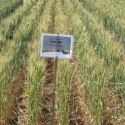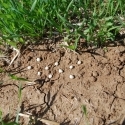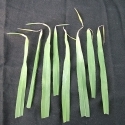Balanced nutrition in Brassica napus production with emphasis on S fertilizer requirements
Balanced nutrition in Brassica napus production with emphasis on S fertilizer requirements
Thomas Jensen, Robert Norton, and Vladimir Nosov.
International Plant Nutrition Institute (IPNI), respectively Northern Great Plains, Australia New Zealand, and Southern and Eastern Russia.
Abstract: Brassica species, including canola, are grown as part of a rotation with other crops such as cereals in many places around the world. One of the on-going agronomic challenges for Brassica crops is proper nutrient management because canola has somewhat different nutrient demands compared to cereals. For example, research in western Canada and Australia suggests that the ideal ratio of supplying nitrogen (N) and sulphur (S) from soil and fertilizers in cropping systems alters when canola is included. Small grain cereal crops such as wheat or barley do well with N:S ratios of around 10 to 12:1 as applied in fertilizer applications but an N:S ratio of 6:1 results in improved canola growth, due to its higher S requirements. Research in Russia has also shown importance of attention to S nutrition.
Introduction
In much of the rapeseed-canola (Brassica napus L.) growing areas in the drier rain-fed cropping areas of the prairie provinces of Canada, southeastern and Western Australia, where no-till cropping systems are predominant. In Russia, rapeseed is grown in all parts of the country (from the European part to Siberia), excepting the Far East. Winter rapeseed is predominant in the South, and mostly spring rapeseed is cultivated in other parts of the country, and conservation tillage is still being adopted. The nutritional requirements of rapeseed-canola are different to cereals, and developing a crop nutrient management plan should consider that canola has higher sulphur (S) requirement, is likely more sensitive to soil acidity (in particular high levels of exchangeable aluminium) (Hocking et al, 1999) and has similar total N and P removals to cereals (Table 1).
Table 1, Approximate nutrient removals (kg/ha) in canola and wheat crops. Nutrient densities from Reuter and Robinson (1997).
Canola (2 t/ha) | Wheat (3 t/ha) | |
Nitrogen | 60 | 63 |
Phosphorus | 10 | 9 |
Potassium | 14 | 11 |
Sulphur | 10 | 4 |
Traditionally farmers have applied all the P, K, low rates of S, and any required micronutrients for cereal crops (mostly wheat and barley) as seed-row starter fertilizers. This is done because of excellent uptake of P and K, both of which are slowly mobile in soils, as well as for convenience of fertilizer handling. The typical P source for arable crops is MAP (mono-ammonium phosphate) applied at sowing in the drill row. MAP (11-23-0-1, N-P-K-S) supplies a small amount of N but has very little S, so this strategy is satisfactory for cereal crops because of the low rate of required S, usually a maximum of 10 kg S ha-1applied. , However, the S demand for Brassicas is significantly higher than for cereals, and canola is more susceptible to damage from seed-placed fertilizers, so alternative strategies have been developed..
In Canada and Australia, the majority of N is applied using urea (46-0-0-0) as a pre-plant band, or at planting side-band application. The main S fertilizer used is ammonium sulphate (21-0-0-24), and the P fertilizer is mono-ammonium phosphate (11-23-0-1). In Australia, gypsum (CaSO4.2H2O) is also used as a sulphur source but it has a lower solubility than sulphate S from ammonium sulphate. Common N, P, K, and S rates for canola are 110 kg N ha-1, 15 kg P ha-1, 12 kg K ha-1, and 20 kg S ha-1, and the accompanying seed-row N rate along with the P, K and S is about 25 kg N ha-1, with the remaining N banded away from the seed-row. The recommended safe rate of N applied in the seed row for canola using a no-tillage planter with 2.5 cm seed-fertilizer lateral spread on a 23 cm shank spacing is 11 kg N ha-1 (SK Ag 2009). So if a farmer applies all the ammonium sulphate in the seed row blend, the 25 kg N can reduce stand emergence due to N-ammonia toxicity to geminating canola seeds. There are various strategies used to supply sufficient S for the canola crop in the cropping rotations while avoiding excess seed-row N and the accompanying ammonia toxicity. Fertilizer application rates to canola-rapeseed in Russia are much lower than rates used in Canada and Australia.
Alternate S Fertilizer Application Methods for Canola - Applying the 4-R Nutrient Stewardship Principles
The 4-R Nutrient Stewardship Principles are that the Right Source of Nutrient is applied at the Right Rate, Right Time and Right Place to supply crop nutrient needs. These principles apply to all plant nutrients that are added as a supplement to nutrients used from the soil. S can be added in different sources and many sources can be effective if managed in the right way. Application of ammonium sulphate in the seed-row of canola could be very effective, but because required rates cause the N in the ammonium sulphate to exceed the ammonia tolerance of canola, germinant mortality can be high and establishment of an adequate plant population stand is at risk. The following are alternative ways of applying the 4-R principles to supply adequate amounts of needed S for the canola crop by changing the form and or placement of the S-containing product:
1. Spread out the needed application of S through the whole crop rotation. This is done by applying greater than needed rates of S in the seed-row fertilizer blend of other crops in rotation with canola. For example in western Canada a possible crop rotation where canola is grown is a three-year rotation of canola-barley-wheat. Rates of nutrients in the seed-row blend of the barley and wheat are usually about 14 kg N, 11 kg P, 10 kg S, and 8.3 kg K ha-1.but both these cereal crops can tolerate higher rates of N contributed from the ammonium phosphate and ammonium sulphate components of the seed-row blend. They can tolerate at least twice this rate of N, so an additional 5 kg S ha-1 can be safely applied during the two years of cereal crops and the total amount of required S (40 kg S ha-1) over the three-year rotation is achieved by 10 kg S ha-1 in the canola year, 15 kg S ha-1 in the wheat year and 15 kg S ha-1 in the barley year. This in comparison to trying to apply 20 kg S ha-1 in the canola plus only 10 kg S ha-1 in each year of the wheat and barley respectively. The S not used by the cereal crops remains residual in the soil and is used by the canola crop. Research has not shown significant losses of S due to leaching of sulphate or volatile H2S emissions under wet conditions in these rotations.
2. Apply the S along with all other fertilizers in a side-band away from the seed-row. Some growers avoid all possible seed-row toxicity by banding all the fertilizer away from the seed-row in a precision placed band usually at least 4 cm to the side and slightly below the seed-row. This band contains the N, the majority of which is in the urea form, plus all the above mentioned seed-row fertilizer. Having the ammonium phosphate, ammonium sulphate and potassium chloride (KCl) in the side-band avoids excess ammonia-N in the seed-row, but may delay access of the canola roots to beneficial P, K and S nutrients because of the high level of N present in the side-band that is hard on roots until the N is moved and diluted by soil moisture. This fertilizer placement strategy works reasonably well however, and is quite widely used.
3. Apply the S in a mid-row band along with the N, while the P and K are still applied in the seed-row. This method also works quite well to supply early P and K along with the smaller amount of N in the ammonium phosphate. This results in improved early seedling growth, especially if the weather is cool and dry in the spring. The sulphate-S in the mid-row band with the majority of N from the urea is quite mobile in the soil and moves to crop roots in sufficient time to supply crop needs.
4. Apply S later in the growth of the crop. Because canola has a good capacity to recover from mild nutrient stress, provided soil levels are adequate for early growth, an alternative strategy is to top-dress sulphate S sources, preferably before stem elongation which is the period of peak nutrient demand for canola.
5. Apply a source of S that has both sulphate and fine-particle sized elemental S in the seed-row. The sulphate-S portion is available immediately to the crop while the elemental S will need to be oxidized to supply sulphate-S for crop use. Some growers use a straight elemental form of S, but even if the product has been formulated with a high portion of small particle sized S, when it is placed in a seed-row, or in a side-band the oxidation rate of the elemental-S has been slow, e.g. 3 to 4 years under most conditions. By using a 50:50 mixed sulphate-S and fine particle sized elemental-S product, the sulphur needs of the canola crop has been better supplied. Examples of available sulphate and elemental S-containing fertilizers are as follows:
a. A physical blend of ammonium sulphate granules mixed with finely ground elemental particles in a granule that has 10% bentonite (swelling) clay mixed that helps in dispersing the elemental S particles (e.g. TigerSul Industries).
b. A compound fertilizer granule made up of layers of ammonium phosphate, ammonium sulphate and fine-sized elemental S (e.g. Incitec Pivot/Shell Thiogro technology, or Mosaic Inc. MES technology).
Conclusions
Growing canola in rotation with cereal crops requires more attention to S management. Applying all required S in the seed-row blend of canola is difficult because of excess N coming from the ammonium phosphate and ammonium sulphate that is part of the blend. There are alternative ways to supply sufficient S and avoid excess N in the seed-row.
References
Blair, G (2010) Responses to sulphate and elemental S in six provinces in China and the utility of mono-calcium phosphate extractable S in predicting soil S status. Proceedings of International Soil Science Congress, Brisbane, 2010. http://www.iuss.org/19th%20WCSS/Symposium/pdf/2138.pdf
Brennan, RF, MDA Bolland (2006). Soil and tissue tests to predict the sulphur requirement of canola in south-western Australia, Australian Journal of Experimental Agriculture. Vol 46, page 1061-1068.
Hocking P, R Norton, A Good (1999), “Canola nutrition”, In Canola in Australia – the first thirty years. (Eds PA Salisbury, TD Potter, G McDonald, AG Green). (Organising Committee for the Tenth International Rapeseed Congress, Canberra). p. 15-22.
Mosaic. http://www.mosaicco.com/products/specialty_products_microessentials_s15_13-33-0-15.htm
P J Hocking, A Pinkerton, A Good (1996) Recovery of field-grown canola from sulphur deficiency.Australian Journal of Experimental Agriculture, 36, 79-85.
Reuter DJ, JB Robinson (Eds) (1997), Plant Analysis: - an interpretation manual (2nd Edition), CSIRO Australia.
Saskatchewan Ministry of Agriculture (SK Ag), 2009, Farm Facts: Guidelines for safe rates of fertilizer placed with the seed. http://www.agriculture.gov.sk.ca/Default.aspx?DN=e42316e3-15ea-4249-ac0e-369212b23131
Tiger-Sul Products. http://www.tigersul.com/products/agriculture/bentonite-sulphur.html
Additional Resources
Jensen et al IRC 13 2011.pdfSize: 0.92 MB




